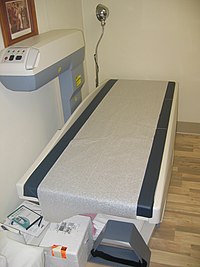
Photo from wikipedia
Importance Increased levels of high-density lipoprotein cholesterol (HDL-C) have been associated with osteoporosis. Preclinical studies have reported that HDL-C reduces bone mineral density by reducing osteoblast number and function. However,… Click to show full abstract
Importance Increased levels of high-density lipoprotein cholesterol (HDL-C) have been associated with osteoporosis. Preclinical studies have reported that HDL-C reduces bone mineral density by reducing osteoblast number and function. However, the clinical significance of these findings is unclear. Objective To determine whether higher HDL-C levels are predictive of an increased fracture risk in healthy older adults. Design, Setting, and Participants This cohort study is a post hoc analysis of data from the Aspirin in Reducing Events in the Elderly (ASPREE) clinical trial and the ASPREE-Fracture substudy. ASPREE was a double-blind, randomized, placebo-controlled primary prevention trial of aspirin that recruited participants between 2010 and 2014. These comprised community-based older adults (16 703 Australians aged ≥70 years, 2411 US participants ≥65 years) without evident cardiovascular disease, dementia, physical disability, and life-limiting chronic illness. The ASPREE-Fracture substudy collected data on fractures reported postrandomization from Australian participants. Cox regression was used to calculate hazard ratio (HR) and 95% CI. Data analysis for this study was performed from April to August 2022. Exposure Plasma HDL-C. Main Outcomes and Measures Fractures included were confirmed by medical imaging and included both traumatic and minimal trauma fractures. Fractures were adjudicated by an expert review panel. Results Of the 16 262 participants who had a plasma HDL-C measurement at baseline (8945 female participants [55%] and 7319 male [45%]), 1659 experienced at least 1 fracture over a median (IQR) of 4.0 years (0.02-7.0 years). In a fully adjusted model, each 1-SD increment in HDL-C level was associated with a 14% higher risk of fractures (HR, 1.14; 95% CI, 1.08-1.20). The results remained similar when these analyses were stratified by sex. Sensitivity and stratified analyses demonstrated that these associations persisted when the analyses were repeated to include only (1) minimal trauma fractures, (2) participants not taking osteoporosis medications, (3) participants who were never smokers and reported that they did not drink alcohol, and (4) participants who walked outside for less than 30 minutes per day and reported no participation in moderate/vigorous physical activity and to examine only (5) statin use. No association was observed between non-HDL-C levels and fractures. Conclusions and Relevance This study suggests that higher levels of HDL-C are associated with an increased fracture risk. This association was independent of common risk factors for fractures.
Journal Title: JAMA cardiology
Year Published: 2023
Link to full text (if available)
Share on Social Media: Sign Up to like & get
recommendations!